
ÖREBRO CASTLE
The name of Örebro comes from the small stones, that a river transports. In Swedish they are called "ör".
 |
The second part of the word comes from the bridge ("bro"), that was built over this ford. Important roads were passing by here - it was a very strategic place, because from here one could control the traffic and the trade in the inner parts of Sweden.
In 1364 Albrecht von Mecklenburg captured a fortress in Örebro. Probably that was an antecessor of today's castle, which had been built on the small island within the Svartå (Black river). The fortress is supposed to have consisted of a defence tower with a surrounding wall, but exactly when it was built, is not known. |
About the next centuryshift the defence was strengthened, which didn't detain the fighter for freedom, Engelbrekt, to take the castle in 1434. One year later he got the castle as well as its surroundings as fiefdom, something he couldn't delight in very long, because another year later he was murdered.
Some years later, the King of the Union, Christopher von Bayern (Christoph III), gave the castle to his spouse, Dorothea von Brandenburg, as a morning gift. On his way to become king, Gustav Wasa laid siege to the castle, which now was called "Örebro Hus" (House of Örebro). After nine months the Danish bailiff Anders Pederson capitulated.
In 1573 Duke Charles, who later was to become King Charles IX, started a rebuilding of the castle. He had the medieval fortress torn apart and built a renaissance castle, surrounded by the round towers, that can be seen yet today. He and his son, Gustav II Adolf, held quite some Diets in the castle, even though it was not finished yet. |
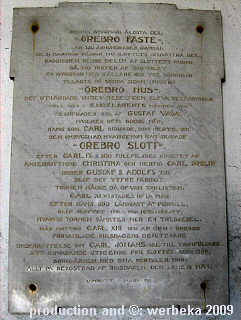 |
Here Charles IX threatened to abdicate in the year 1606, shouldn't he get more support in his fight against catholicism within the country. In 1610 he had fallen victim to a stroke and the fifteen year old son held the speech to the delegates.
| One year later Gustav II Adolf was declared of full age within these chambers. But when the castle finally was completed in 1627, the heydays of Örebro had already passed and the castle began to decay. It found a new role in being used as a jail and a storage until the middle of the 18th century, when it - according to plans by Carl Hårleman - was thoroughly restaurated. The cupolas of the towers were torn down and replaced by much flatter roofs. The renaissance looks had to give way to more classicistic forms. When the Royal chambers were rebuilt in 1764, the castle became the residence of the regional governors. But when the newly married Royal couple, Gustaf III and Sophia Magdalena of Denmark, were to stay in Örebro on their honeymoon, the governor bedighted some of the rooms for their Highnesses out of his own pocket. But when the couple arrived at the city, they had already gotten enough of each other. Gustaf left his spouse in this castle and thus never even stayed overnight. Later the governor himself moved into these rooms.
|
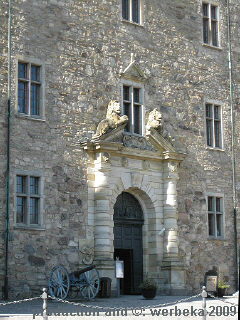 |
There were several reasons why Gustaf and Sophie didn't like each other. The extrovert and intelligent Gustaf detested his quiet and religious wife, who in her turn disliked the din, caused by the attendence, that Gustaf liked to see around him. The marriage was fulfilled a couple of years later - they got two sons - but the emotions cooled down rather quickly again.
During the Diet of 1810 King Charles XIII lived in the castle, when his successor was elected in the church of St. Nicolai. That was Charles XIV John, the forefather of today's Royal family.
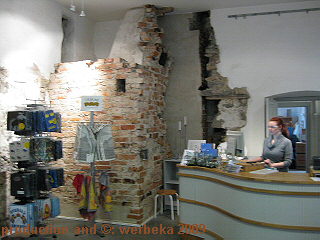 |
A last rebuilding, at which the roofs of the towers were hightened again, happened at the turn to the 20th century. During this century the castle was mostly used as residence for the regional governor and as office for the regional administration. Though the latter moved in 1992 and since then the castle is open for the public.
In the reception, which also is used as shop, tickets for a guided tour can be bought. There is also a part of a wall shown, which dates back to the 14th century and that has been laid open. |
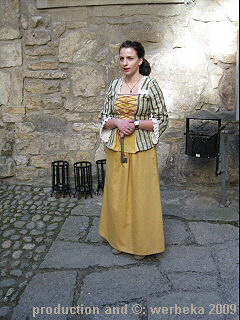 |
The guided tour starts in the yard, and it is explained that the entrance doors, remaining from the time of Duke Charles have different hights, because it was not comme il faut that the Duke and his spouse should use the same door. But inside both doors lead to the same staircase ... Hypocrisy is really not a very modern invention, as we can see by this example.
|
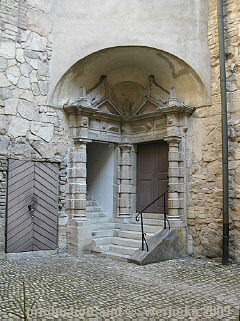 |
Of course the guide talks Swedish, but afterwards she delivers the same explanations in an excellent English, if so should be necessary. The tour starts in the cellar, the former jail, where today there are birthday parties and other events for children celebrated.
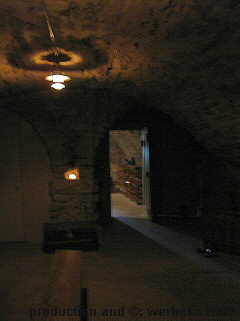 |
Naturally you get to hear the story about Lasse-Maja, the well-known thief, who often wore womens' clothes, when out on "business". Vested like this he is said to have succeeded to flee from this jail as well. Even today he sneaks around in the staircases of the castle, as we can se on the image to the right. But this sneaking is one of the very highlights, which are to be seen. |
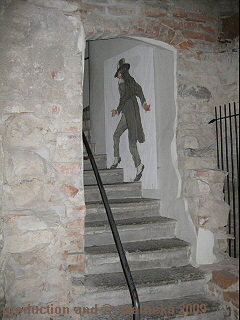 |
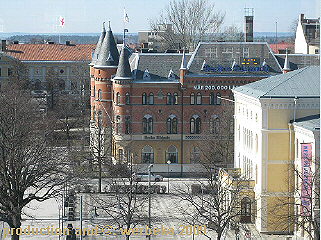 |
The rest of the castle is more or less empty - you are guided stairs up and stairs down, hear about some really interesting stories from the past, but the historical atmosphere has been blown away by two centuries of burocracy, while the regional government was allowed to mismanage everything. You see walls, painted with plastic colours instead of more suitable plastering and you see rooms without furniture, or, in the best case, with such from our time. The view onto the Svartå and the building of the dignified newspaper "Nerikes Allehanda" are among the most interesting experiences. |
The foldable tables in one of the conference rooms really are of respectable age, but you would rather expect them in a school's dining room from the Sixties.
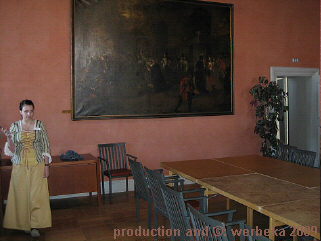 |
Using them here as a complement to historical paintings is not very well reasoned. Neither does it help much, that the chairs in the nearby State Hall are clad in blue cloth, which has the outlines of the castle woven into it as a pattern.
Apart from these shortcomings the content of the guiding tour should be mentioned in honour. For instance you get to know, that the upper floors were the working rooms for the servants and that - because of this circumstance - the stairs are much higher than further below, so that the people of the Court wouldn't have had to climb so high. |
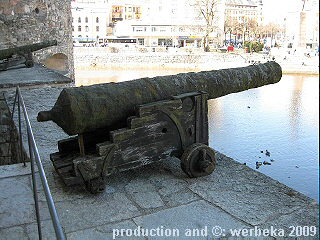 |
Short stories among the historical facts contribute to make the guiding more entertaining. So shall Gustav Wasa have been ashamed of the form of his legs and summond his soldiers to line up without trousers, in order to select one of them to be a stand-in, representing his legs on a painting to be made ... Another story there is about the cannons, less amusing though - at least for the German tourist, who was involved in it. On the evening before the First of May the cannons always were used "to greet springtime". They then were filled with material, which only should have given a loud bang. |
But a couple of years ago the whole package flew out of the cannon, right over the Svartå and onto the opposite bank, where a spectator's leg was blown off. Since then the cannons are not used anymore.
Without doubt the guiding is recommendable - only through that it makes the visit worthwhile.
© Bernhard Kauntz, Wolvertem, 2009
Back to  or to the or to the  of of 
page created: 22.4.2009 by webmaster@werbeka.com
|













